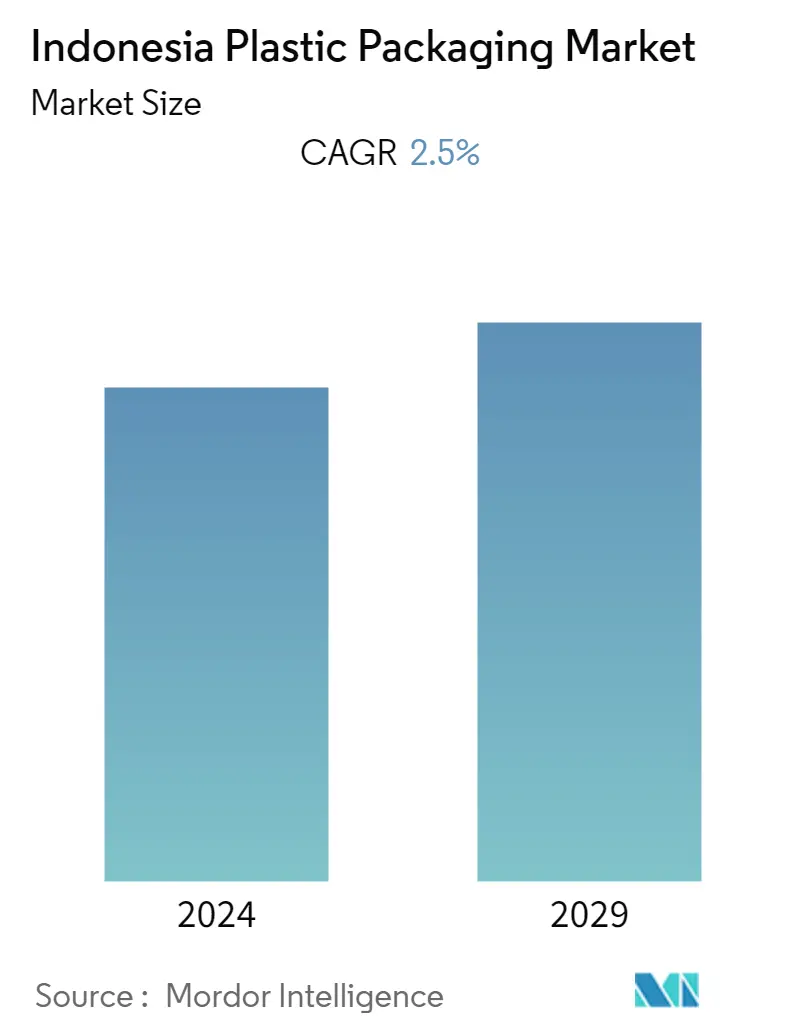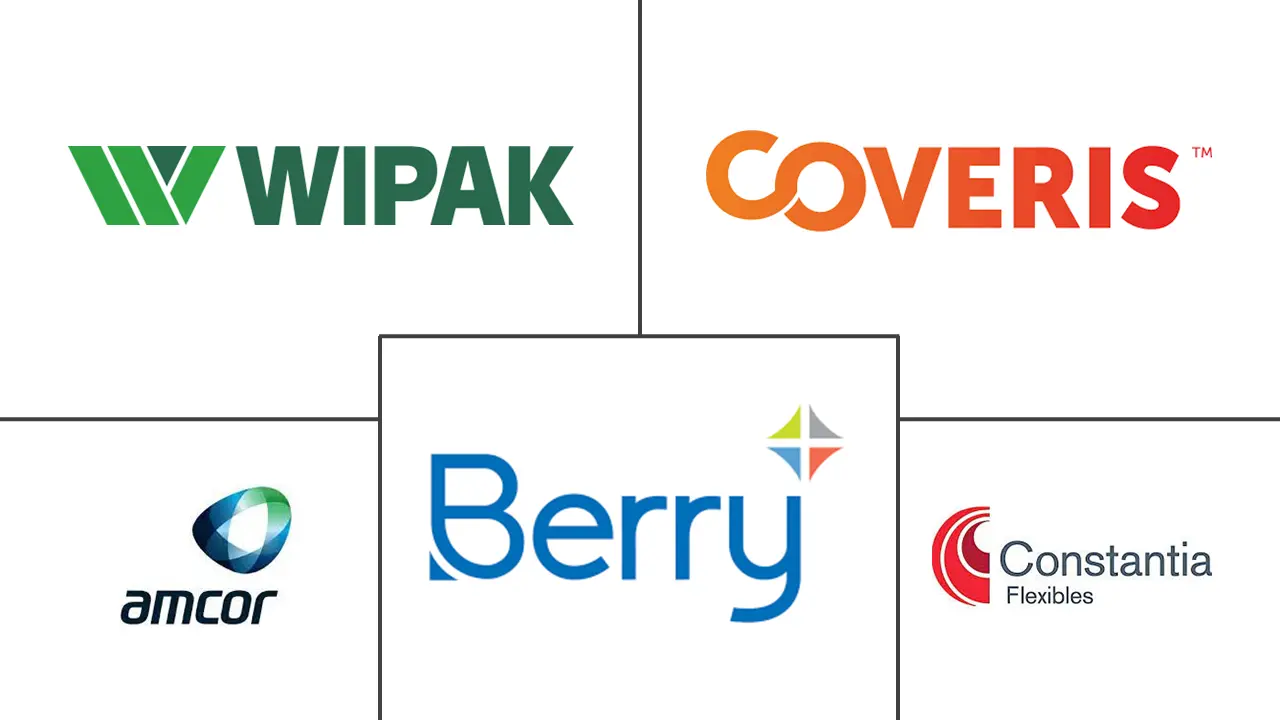Market Size of Indonesia Plastic Packaging Industry

| Study Period | 2019 - 2029 |
| Base Year For Estimation | 2023 |
| Forecast Data Period | 2024 - 2029 |
| Historical Data Period | 2019 - 2022 |
| CAGR | 2.50 % |
| Market Concentration | Medium |
Major Players
*Disclaimer: Major Players sorted in no particular order |
Indonesia Plastic Packaging Market Analysis
The Indonesian plastic packaging market is expected to register a CAGR of 2.5% over the forecast period. Owing to the COVID-19 pandemic, food and beverage companies are developing response actions and effective plans to help mitigate their risk and prepare for how they would deal with the effects of the coronavirus. These plans include establishing an interdisciplinary crisis response team of personnel from all aspects of the business to identify, assess, and manage the risk presented.
- The increasing technological advancements and end-user industry packaging applications are the significant factors driving the growth of the market studied. In most of Indonesia, the population is growing, and the use of packaging per person is increasing. It is also growing due to consumer behavior trends, such as the growth in the use of convenience products and the increasing use of plastic as a substitute for other packaging materials.
- Plastic packaging has implemented new ways for the functioning of the packaging industry. Packaging solutions that are durable, lightweight, and comfortable have augmented the use of plastics as a packaging material across the region.
- The price of LDPE packaging is currently low in the region, which means that there will be minimal impact on the sellers from the additional cost of using the material. The demand for surgical masks, which are made of materials such as polypropylene, polyisoprene, and polyurethane, has also increased.
- Plastic pollution has become a global problem. Several types of research have stated plastic's adverse effects on the environment. Owing to this, Indonesia also implemented regulations to reduce the use of plastics. The Indonesian plastic packaging market is facing serious concerns due to the plastic resin price rise. This is leading to increased lags in recovering higher costs of resin and reduced profitability among established local players.
- Additionally, to fund a response to the COVID-19 pandemic, the Indonesian government introduced a fiscal stimulus package worth trillions of rupiah and increased its state budget deficit above the 3% legal limit. The country's current flexible packaging market players are anticipated to benefit from this. However, breaking even for newcomers may provide unheard-of difficulties. There is also the impact of the Russia-Ukraine war on the overall packaging ecosystem.
Indonesia Plastic Packaging Industry Segmentation
Plastic packaging is a part of the multi-faceted system for providing products from the point of manufacture to the point of consumption. Its principal purpose is to guard and ensure the safe and secure delivery of the product to the end user. Its role in a circular economy is to sustain the value of a product for as long as required and to help remove product waste. The Indonesian plastic packaging market is tracked based on consumption in the domestic market and is segmented by packaging type (rigid plastic packaging and flexible plastic packaging), by end-user vertical (food, beverage, healthcare, personal care and household, and other end-user verticals), and by product type (bottles and jars, pouches and bags, trays and containers, films and wraps, and other product types). The market sizes and forecasts are provided in terms of value (USD million) for all the above segments.
Indonesia Plastic Packaging Market Size Summary
The Indonesian plastic packaging market is experiencing a steady growth trajectory, driven by technological advancements and increasing demand from end-user industries. The market's expansion is supported by the growing population and rising per capita consumption of packaging materials, particularly in the food and beverage sectors. The shift in consumer behavior towards convenience products and the preference for plastic over other materials due to its durability, lightweight, and cost-effectiveness are significant contributors to this growth. Despite the challenges posed by plastic pollution and regulatory measures aimed at reducing plastic use, the market continues to thrive, with innovations in packaging solutions and materials like PET and LDPE playing a crucial role. The COVID-19 pandemic has further influenced the market dynamics, prompting a shift from traditional distribution methods to online platforms, thereby altering the landscape of cosmetic and personal care product packaging.
The market is moderately concentrated, with major players such as Amcor, Coveris Holding, and Berry Global leading the charge. Recent investments and joint ventures, like those by Oji Holdings Corporation and Toyobo Co. Ltd, highlight the ongoing efforts to meet the increasing domestic demand for packaging solutions. These developments are complemented by initiatives aimed at enhancing recycling capabilities and reducing single-use plastic consumption, as seen in the efforts by CMA CGM Group and Coca-Cola Euro-Pacific Partners. The lightweight nature of plastic continues to drive its adoption in various packaging applications, from beverage containers to skincare products, offering advantages in transportation and consumer convenience. As the market evolves, the focus on sustainable practices and innovative packaging technologies is expected to shape its future trajectory.
Indonesia Plastic Packaging Market Size - Table of Contents
-
1. MARKET INSIGHTS
-
1.1 Market Overview
-
1.2 Industry Value Chain Analysis
-
1.3 Industry Attractiveness - Porter's Five Forces Analysis
-
1.3.1 Bargaining Power of Suppliers
-
1.3.2 Bargaining Power of Consumers
-
1.3.3 Threat of New Entrants
-
1.3.4 Threat of Substitute Products
-
1.3.5 Intensity of Competitive Rivalry
-
-
1.4 Impact of COVID-19 on the Market
-
1.5 Overview of the Global Plastic Packaging Market
-
1.6 Market Drivers
-
1.6.1 Increasing Adoption of Lightweight Packaging Methods
-
1.6.2 Increased Eco-friendly Packaging and Recycled Plastic
-
-
1.7 Market Challenges
-
1.7.1 High Price of Raw Material (Plastic Resin)
-
1.7.2 Government Regulations and Environmental Concerns
-
-
Indonesia Plastic Packaging Market Size FAQs
What is the current Indonesia Plastic Packaging Market size?
The Indonesia Plastic Packaging Market is projected to register a CAGR of 2.5% during the forecast period (2024-2029)
Who are the key players in Indonesia Plastic Packaging Market?
Amcor Plc, Coveris Holding, Berry Global, Constantia Flexibles and Wipak Group are the major companies operating in the Indonesia Plastic Packaging Market.

